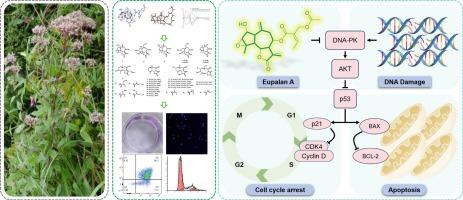泽兰倍半萜类化合物通过DNA-PK/AKT/p53通路诱导AGS细胞G0/G1细胞周期阻滞和凋亡
IF 4.7
2区 医学
Q1 BIOCHEMISTRY & MOLECULAR BIOLOGY
引用次数: 0
摘要
从中国泽兰(Eupatorium chinense L.)中分离得到10个未被描述的倍半萜,包括5个未被描述的瓜蓝烷型倍半萜(1-5)和5个未被描述的双马兰烷型倍半萜(6-10),以及14个已知的类似物(11-24)。它们的结构通过光谱数据(UV、NMR、ECD、HRESIMS和DP4+)进行了分析。研究了倍半萜衍生物(1-24)对5种人类癌细胞系(Hep3B、A549、AGS、MCF-7和HCT-116)的细胞毒性。其中化合物1对胃腺癌AGS细胞株的细胞毒活性最强,IC50值为4.33 μM。机制研究表明,化合物1抑制AGS细胞中DNA-PK/AKT/p53信号通路。同时,它上调p21蛋白表达,下调CDK4和cyclin D蛋白水平,诱导G0/G1期细胞周期阻滞。此外,化合物1通过增加Bax表达、降低Bcl-2表达促进细胞凋亡。总之,这些发现确立了化合物1作为开发新型抗胃癌疗法的有希望的先导候选物。本文章由计算机程序翻译,如有差异,请以英文原文为准。

Sesquiterpenoids from Eupatorium chinense L. induce G0/G1 cell cycle arrest and apoptosis in AGS cell via DNA-PK/AKT/p53 pathway
Ten undescribed sesquiterpenes, including 5 undescribed guaiane-type sesquiterpenes (1–5) and 5 undescribed gemmarane-type sesquiterpenes (6–10), along with fourteen known analogues (11–24) were isolated from the whole plants of Eupatorium chinense L. They structures were determined by interpretation of spectroscopic data (UV, NMR, ECD, HRESIMS, and DP4+). The cytotoxicity of sesquiterpene derivatives (1–24) was evaluated against five human cancer cell lines (Hep![]() 3B, A549, AGS, MCF-7, and HCT-116). Among these, compound 1 exhibited the most potent cytotoxic activity against the gastric adenocarcinoma AGS cell line, with an IC50 value of 4.33 μM. Mechanistic studies revealed that compound 1 suppresses the DNA-PK/AKT/p53 signaling pathway in AGS cells. Concomitantly, it upregulates p21 protein expression while downregulating CDK4 and cyclin D protein levels, inducing G0/G1 phase cell cycle arrest. Furthermore, compound 1 promotes apoptosis by increasing Bax expression and decreasing Bcl-2 expression. Collectively, these findings establish compound 1 as a promising lead candidate for the development of novel anti-gastric cancer therapeutics.
3B, A549, AGS, MCF-7, and HCT-116). Among these, compound 1 exhibited the most potent cytotoxic activity against the gastric adenocarcinoma AGS cell line, with an IC50 value of 4.33 μM. Mechanistic studies revealed that compound 1 suppresses the DNA-PK/AKT/p53 signaling pathway in AGS cells. Concomitantly, it upregulates p21 protein expression while downregulating CDK4 and cyclin D protein levels, inducing G0/G1 phase cell cycle arrest. Furthermore, compound 1 promotes apoptosis by increasing Bax expression and decreasing Bcl-2 expression. Collectively, these findings establish compound 1 as a promising lead candidate for the development of novel anti-gastric cancer therapeutics.
求助全文
通过发布文献求助,成功后即可免费获取论文全文。
去求助
来源期刊

Bioorganic Chemistry
生物-生化与分子生物学
CiteScore
9.70
自引率
3.90%
发文量
679
审稿时长
31 days
期刊介绍:
Bioorganic Chemistry publishes research that addresses biological questions at the molecular level, using organic chemistry and principles of physical organic chemistry. The scope of the journal covers a range of topics at the organic chemistry-biology interface, including: enzyme catalysis, biotransformation and enzyme inhibition; nucleic acids chemistry; medicinal chemistry; natural product chemistry, natural product synthesis and natural product biosynthesis; antimicrobial agents; lipid and peptide chemistry; biophysical chemistry; biological probes; bio-orthogonal chemistry and biomimetic chemistry.
For manuscripts dealing with synthetic bioactive compounds, the Journal requires that the molecular target of the compounds described must be known, and must be demonstrated experimentally in the manuscript. For studies involving natural products, if the molecular target is unknown, some data beyond simple cell-based toxicity studies to provide insight into the mechanism of action is required. Studies supported by molecular docking are welcome, but must be supported by experimental data. The Journal does not consider manuscripts that are purely theoretical or computational in nature.
The Journal publishes regular articles, short communications and reviews. Reviews are normally invited by Editors or Editorial Board members. Authors of unsolicited reviews should first contact an Editor or Editorial Board member to determine whether the proposed article is within the scope of the Journal.
 求助内容:
求助内容: 应助结果提醒方式:
应助结果提醒方式:


